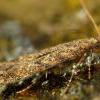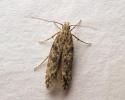35.127 Tuta absoluta (Meyrick, 1917)
Status and Distribution
An adventive pest species of Neotropical origin, first introduced into Europe (Spain) in 2007. Since then, has been found in Morroco, Algeria and the Netherlands (2008), spreading further and extensively across Europe, including France between 2009 and 2010.
Initially associated with imported tomatoes, but since the first wild caught specimens in England (three sites in 2010), it has been attracted to light traps on an increasing number of occasions. This has occurred over a wide geographical area in situations that indicate populations may have, temporarily, become established in the wild, such as in the Midlands, as well as arriving as a primary immigrant at light traps in southern and eastern England and southern Ireland. The first record for Scotland was noted at an MV light trap in Ayrshire on 1st August 2024.
Proof of more permanent establishment of a wild population would require evidence of use of plants such as Solanum dulcamara (bittersweet) or areas where tomato plants survive outdoors.

Provisional map
Foodplant and Larval Feeding Signs
On imported Lycopersicon esculentum (tomatoes) where it can be a serious pest. Abroad it has also been reported as a pest on Solanum muricatum (pepino dulce), S. melongena (aubergine), S. nigrum (black nightshade), S. puberulum, S. lyratum, S. elaeagnifolium (silver-leaved nightshade), Datura stramonium (thornapple), D. ferrox (long-spined thornapple), Nicotiana glauca (tree tobacco), Lycium chilense and Lycopersicon hirsutum (wild tomato).
The larva may feed on many different parts of the food-plant including mining the leaves in a central white blotch with side galleries containing areas of frass or will bore into buds, stalks and fruits.
Habitat
In the wild there is no specific habitat association currently known in the British Isles. Records in these circumstances have been at light traps in inland gardens and coastal or near coastal localities, the latter indicating primary immigration as the most likely source.
Finding the Moth
Larva: can be found on imported tomatoes feeding on the fruits producing small circular holes (or larger lesions) within a discoloured area on the skin. The larva is also known to mine the leaves and stems and should be looked for on home grown tomatoes as well as related plants in the wild, such as the nightshades.
The mine in the leaves is similar to that of Scrobipalpa costella, the larva of which has segments two and three (the area behind the broad blackish prothoracic plate) a dull purplish brown colour. In T. absoluta this area is yellowish to pale green beyond the narrower black plate. The larva of Acrolepia autumnitella, another species that feeds on Solanaceae, lacks the black pro-thoracic plate.
Adult: attracted to light and, as a migrant species, is increasingly being encountered in south-east and southern coastal areas.
Similar Species
Very similar to a few Scrobipalpa species, particularly Scrobipalpa atriplicella, with which it shares the cream-coloured underside to the abdomen and the grey, black and orange-brown mottling on the forewings. Tuta absoluta (wingspan 10 - 12mm) is generally smaller than S. atriplicella, but with some overlap, and has more slender wings. The third segment of the labial palps have two distinct dark rings in T. absoluta whereas in S. atriplicella segment three is more generally mottled dark fuscous on a pale background. Dissection may be required in worn specimens or with smaller specimens of S. atriplicella (11 - 17mm wingspan).
An almost black specimen with a whitish subterminal fascia was attracted to light in Suffolk during 2016 (Raymond Watson pers. comm.).
Recorded in the wild (at light) from early June to late October and with a single record in mid-December. May appear at other times of the year if the larva has fed inside greenhouses etc.







